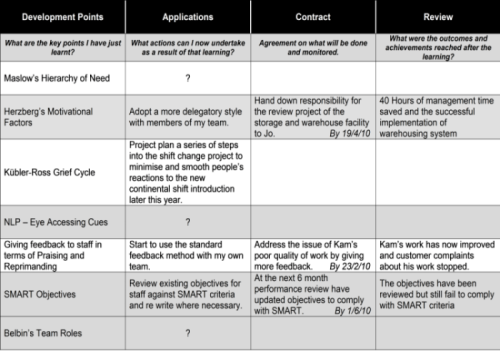‘Transferring development into action doesn’t have to be a challenge,’ says Garry Platt.
 "During the learning process the learner is given the opportunity to stop and reflect on what they have just acquired in terms of knowledge and skills. This process should not seek to capture everything but rather the essential learning point."
"During the learning process the learner is given the opportunity to stop and reflect on what they have just acquired in terms of knowledge and skills. This process should not seek to capture everything but rather the essential learning point."
In this example the contract is still work in progress and originates from a management development programme the learner participated in. During the programme the first two columns should have been completed. In this instance three items were only partially finished, one appertaining to Maslow’s Hierarchy of Needs, the other NLP Eye Accessing Cues and the third Belbin’s Team Roles. In these examples the learner cannot see how they might apply or use the learning. Is this a failing in the delivery to contextualise the material? Or is the content without much merit, having little practical use? Or has the learner failed to establish the connection? What ever the answer, the learning has been of no use and surely a waste of time and money. The reasons for this should be explored.
In the given example three of the listed factors have been taken up by the learner’s line manager under the contract section (3rd Column) and further action agreed. The results in two of these cases, the Herzberg and Feedback content have produced tracked positive outcomes. The third item, relating to writing SMART objectives has failed to transpose into a successful outcome. The reasons for this should be explored.
The benefits of this approach are two fold. From the developer’s and deliverer’s perspective this analysis of the content and its use undoubtedly focuses the mind. Extraneous, irrelevant or frivolous topics are quickly exposed using this methodology and a much more trimmed, concentrated programme of development can result. From the learners perspective knowing what you’ve learnt will be reviewed by ones line manager and then its use and application monitored promotes a degree of attention and awareness during the learning process which otherwise might be absent.
In summary, the process of promoting the application of learning to the workplace follows a three stage process:
- During the developmental process learners are required to maintain a simple learning log, prioritising the key aspects acquired from the event.
- After the developmental event learners agree actions and tasks which will ensure transfer of the learning into the workplace.
- A brief review is undertaken from time to time after the contracting to confirm progress towards the set goals and targets.
By adopting this simply process high level evaluation of the use and benefits of learning can be analysed and hard evidence supplied to support further funding and continuance or clear facts that demonstrate that a programme should either be altered or dropped, either way, it’s all good.
Garry Platt is an experienced training consultant employed by the EEF with more than 25 years experience in the business. He has worked with a number of international organisations helping them to enhance their approach to training and development. Within the last 12 months he has worked with; Deutsche Post DHL, The Body Shop, Severn Trent, Virgin Atlantic Airlines and Network Rail.
Academically qualified to Masters Degree level in Education, Training and Development his work combines current research and study in Human Resource Development with a pragmatic and workable approach. Visit the EEF website for further details: www.eef.org.uk. Gary writes the Platts Puzzlings blog here on TrainingZone as well as managing the Transactional Analysis discussion group.
'Transferring development into action doesn't have to be a challenge,' says Garry Platt.
 "During the learning process the learner is given the opportunity to stop and reflect on what they have just acquired in terms of knowledge and skills. This process should not seek to capture everything but rather the essential learning point."
"During the learning process the learner is given the opportunity to stop and reflect on what they have just acquired in terms of knowledge and skills. This process should not seek to capture everything but rather the essential learning point."
In this example the contract is still work in progress and originates from a management development programme the learner participated in. During the programme the first two columns should have been completed. In this instance three items were only partially finished, one appertaining to Maslow’s Hierarchy of Needs, the other NLP Eye Accessing Cues and the third Belbin’s Team Roles. In these examples the learner cannot see how they might apply or use the learning. Is this a failing in the delivery to contextualise the material? Or is the content without much merit, having little practical use? Or has the learner failed to establish the connection? What ever the answer, the learning has been of no use and surely a waste of time and money. The reasons for this should be explored.
In the given example three of the listed factors have been taken up by the learner’s line manager under the contract section (3rd Column) and further action agreed. The results in two of these cases, the Herzberg and Feedback content have produced tracked positive outcomes. The third item, relating to writing SMART objectives has failed to transpose into a successful outcome. The reasons for this should be explored.
The benefits of this approach are two fold. From the developer’s and deliverer’s perspective this analysis of the content and its use undoubtedly focuses the mind. Extraneous, irrelevant or frivolous topics are quickly exposed using this methodology and a much more trimmed, concentrated programme of development can result. From the learners perspective knowing what you’ve learnt will be reviewed by ones line manager and then its use and application monitored promotes a degree of attention and awareness during the learning process which otherwise might be absent.
In summary, the process of promoting the application of learning to the workplace follows a three stage process:
- During the developmental process learners are required to maintain a simple learning log, prioritising the key aspects acquired from the event.
- After the developmental event learners agree actions and tasks which will ensure transfer of the learning into the workplace.
- A brief review is undertaken from time to time after the contracting to confirm progress towards the set goals and targets.
By adopting this simply process high level evaluation of the use and benefits of learning can be analysed and hard evidence supplied to support further funding and continuance or clear facts that demonstrate that a programme should either be altered or dropped, either way, it’s all good.
Garry Platt is an experienced training consultant employed by the EEF with more than 25 years experience in the business. He has worked with a number of international organisations helping them to enhance their approach to training and development. Within the last 12 months he has worked with; Deutsche Post DHL, The Body Shop, Severn
Academically qualified to Masters Degree level in Education, Training and Development his work combines current research and study in Human Resource Development with a pragmatic and workable approach. Visit the EEF website for further details: www.eef.org.uk. Gary writes the Platts Puzzlings blog here on TrainingZone as well as managing the Transactional Analysis discussion group.






